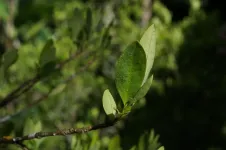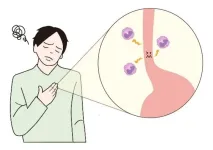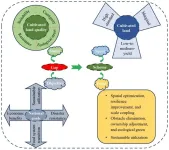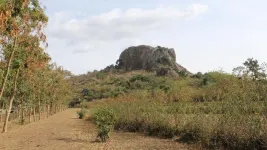A new paper in Molecular Biology and Evolution, published by Oxford University Press, indicates that while the United Nations Office on Drugs and Crime has collected annual data on areas of coca cultivation in South America for decades – to monitor the establishment of illegal plantations and associated deforestation – scientists can’t reliably distinguish between different types of coca plants. While identification often relies on leaf shape and size, this does not reflect differences between coca varieties grown for extracting the alkaloid cocaine (the active ingredient in the recreational drug), coca cultivated for traditional purposes, and wild-growing coca plants.
South American coca has been a keystone crop for many Andean and Amazonian communities for at least 8,000 years, and today it still plays a vital role in the livelihoods of millions of South Americans. People use its leaves, rich in active compounds (cocaine being just one of these), for cultural rituals, medicinal treatments, nutritional supplements, and as an everyday stimulant.
However, over the last half century, global demand for alkaloid cocaine, through industrial levels of extraction of this single compound, has driven intensive agriculture of this plant and placed it at the center of armed conflict and deforestation.
Coca belongs to the diverse genus Erythroxylum, which comprises over 270 different species, many native to the American tropics. Among these, two species of cultivated cocas are found in mostly distinct regions of northwestern South America. Most widely cultivated is Erythroxylum coca (Huánuco coca). Its coca variety is native to wet mountain forests of the eastern Andean slopes of Peru and Bolivia, and its ipadu variety in the Amazonian region. The less widely cultivated Erythroxylum novogranatense has historically been grown in the dry valleys of the Cordilleras and the Sierra Nevada de Santa Marta. Farmers cultivated its truxillense variety (‘Trujillo coca’) in arid regions of north-western Peru for traditional use and it is a flavoring and stimulant additive for the soft drink Coca Cola.
The leaves of these two species—plants grown specifically under human cultivation and adapted to a human environment—were thought to be different from leaves of closely related wild Erythroxylum species by being smaller, rounder and softer. As for distinguishing between the two, leaves of E. coca are, in general, rounder than E. novogranatense. This simple difference has been used in the field for coca plantation monitoring surveys.
But differences in leaf size and shape may not be a reliable way to separate the types of plants. Despite extensive studies, the boundaries between cultivated coca varieties and their wild relatives are poorly defined. To tackle this challenge, the researchers used 1,163 leaf outlines from 342 digital herbarium specimens of wild and cultivated coca to extract size and shape data. Using statistical methods, they showed that there is a high degree of overlap between the species (and their varieties), which has almost certainly led to misidentifications in the field. This also highlights the importance of using diverse sources for plant classification. An inadequate classification system for coca can impede describing new varieties. This is relevant to plantations dedicated to the extraction of cocaine, but importantly, also contributes to knowledge about the identity of varieties with improved traits for alternative uses, such as food supplements, fibers, or pigments already obtained from these plants.
“We are rethinking how to classify coca plants, both cultivated and wild, after adding new data about their leaves and genes,” said Fabio Andrés Ávila of the New York Botanical Garden, one of the paper’s authors. “This is important for Colombia's biodiversity and for communities that use coca for traditional purposes, providing new information sources about the plants they depend on.”
In this study, the researchers also investigated genetic relationships between the coca plants. They compared the results with the existing taxonomic classification, and assessed how well leaf shape and size matched up with genetics and looked at whether this could be used to distinguish species and varieties. Looking at the genetic groupings of coca and using time models allowed them to estimate when different coca species and varieties originated. The findings revealed that distinct coca plants had begun to evolve long before humans first arrived in South America 15,000 years ago, though the timeline for when the cultivated, cocaine-yielding coca plants emerged remains uncertain.
While leaf shape and size revealed traits that are characteristic of cultivated cocas, namely being rounder overall and narrower at the base, the researchers found these characteristics unreliable for identification purposes. Instead, the study highlights the potential of genetic techniques as a more precise method for identifying and monitoring coca populations.
“One of the primary objectives of our research is to propose a stable classification system and a comprehensive genetic database. This will enable us to confidently identify the different populations, varieties and species of cultivated coca and their wild relatives,” said Oscar Alejandro Pérez-Escobar of the Royal Botanic Gardens at Kew, another author of the paper. “Such a system is crucial for developing sustainable bioprospecting programs and the coca tree holds immense potential in this regard. But first, it is essential to separate the plant’s valuable attributes from its association with the recreational drug, reshaping its perception and highlighting its positive uses.”
The paper, “Morphometrics and phylogenomics of coca (Erythroxylum spp.) illuminate its reticulate evolution, with implications for taxonomy,” is available (at midnight on July 10th) at https://academic.oup.com/mbe/article-lookup/doi/10.1093/molbev/msae114.
Direct correspondence to:
Oscar Alejandro Pérez-Escobar
Research Leader, Integrated Monography Team
Royal Botanic Gardens, Kew
London, TW9 3AE, UNITED KINGDOM
O.PerezEscobar@kew.org
To request a copy of the study, please contact:
Daniel Luzer
daniel.luzer@oup.com
END





